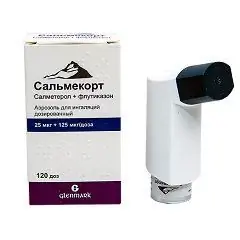- Author Rachel Wainwright [email protected].
- Public 2023-12-15 07:39.
- Last modified 2025-11-02 20:14.
Salmecort
Salmecort: instructions for use and reviews
- 1. Release form and composition
- 2. Pharmacological properties
- 3. Indications for use
- 4. Contraindications
- 5. Method of application and dosage
- 6. Side effects
- 7. Overdose
- 8. Special instructions
- 9. Application during pregnancy and lactation
- 10. Use in childhood
- 11. Drug interactions
- 12. Analogs
- 13. Terms and conditions of storage
- 14. Terms of dispensing from pharmacies
- 15. Reviews
- 16. Price in pharmacies
Latin name: Salmecort
ATX code: R03AK06
Active ingredient: fluticasone (Fluticasonum) + salmeterol (Salmeterolum)
Manufacturer: Glenmark Pharmaceuticals Ltd. (India)
Description and photo updated: 2018-29-11
Prices in pharmacies: from 429 rubles.
Buy

Salmecort is a combined preparation with bronchodilator and anti-inflammatory effects.
Release form and composition
Dosage form - metered dose inhalation aerosol: suspension of almost white or white color, placed in an aluminum aerosol can under pressure with a dispensing valve (in a cardboard box 1 can containing 120 doses of aerosol, and instructions for use of Salmecort).
Active substances in 1 dose:
- salmeterol - 25 mcg (salmeterol xinafoate - 36.3 mcg);
- fluticasone propionate - 50, 125 or 250 mcg.
Auxiliary components: polyethylene glycol 1000; 1,1,1,2-tetrafluoroethane (HFA-134a).
Pharmacological properties
Pharmacodynamics
Salmecort is a combined bronchodilator.
The main properties of active ingredients:
- salmeterol - is one of the long-acting selective β 2 -adrenoceptor agonists (not less than 12 hours). The molecule of the substance has a long side chain linking it to the outer domain of the receptor. Salmeterol, due to this pharmacological property, is more effective in preventing histamine-induced bronchospasm and leads to a longer bronchodilation in comparison with conventional short-acting β 2 receptor agonists. Prolonged and effectively inhibits the release of mast cell mediators in lung tissues, including leukotrienes, histamine and PgD 2… Suppresses both early and late stages of an allergic reaction. After the introduction of a single dose, a decrease in bronchial hyperreactivity is noted, the late-stage inhibitory effect persists for more than 30 hours after application, when the bronchodilating effect is no longer there;
- fluticasone propionate - is a topical glucocorticosteroid. When inhaled in recommended doses, it has a pronounced anti-allergic and anti-inflammatory effect, which leads to a decrease in the severity of symptoms and the number of exacerbations of diseases that are accompanied by airway obstruction. In the case of prolonged use of maximum doses of fluticasone propionate, the daily / reserve secretion of adrenal cortex hormones in adults and children remains within normal limits. After the therapy, the residual decrease in the reserve function of the adrenal glands can persist for a long time.
Pharmacokinetics
There is no information confirming the mutual influence of the active components of Salmecort.
Salmeterol
After inhalation use in therapeutic doses, very low concentrations of the substance are created in the blood plasma (200 pg / ml or less). In the systemic circulation, in the case of regular use of inhaled salmeterol, hydroxynaphthoic acid (up to 100 ng / ml) is determined.
Fluticasone propionate
The relative bioavailability of the substance after inhalation is 10-30% (depending on the drug delivery system). Systemic absorption occurs mainly in the lungs. Part of the inhaled substance can be swallowed, while due to intensive metabolism during the first passage through the liver and poor solubility in water, its systemic effect is minimal. When swallowed, the bioavailability of fluticasone is less than 1%.
There is a direct relationship between the systemic effect of fluticasone and the size of the inhaled dose, the volume of distribution is approximately 300 liters.
Metabolism occurs in the liver, where a substance with the participation of the CYP3A4 system of cytochrome P 450 is metabolized to an inactive metabolite. Less than 5% of the metabolite is excreted in the urine. Plasma clearance - 1.15 l / min. T 1/2 (half-life) is approximately 8 hours.
Indications for use
Salmecort is prescribed for regular use in patients with bronchial asthma if there are indications for combined therapy with a long-acting β 2 -adrenomimetic and a glucocorticosteroid for inhalation use in the following cases:
- insufficient control of the disease in patients who are undergoing continuous monotherapy with an inhaled glucocorticosteroid and periodically use a short-acting β 2 -adrenomimetic;
- the presence of adequate control of the disease against the background of therapy with inhaled glucocorticosteroid and long-acting β 2 -adrenomimetic;
- the need for starting maintenance therapy in patients with persistent bronchial asthma (characterized by the daily occurrence of symptoms and the daily use of drugs for rapid relief of symptoms) in cases of indications for the appointment of glucocorticosteroids to achieve control over the disease;
- the need for maintenance therapy in patients with COPD (chronic obstructive pulmonary disease), in whom the value of FEV1 (forced expiratory volume) is <60% of the proper values (before inhalation of the bronchodilator), with a history of repeated exacerbations, and in whom, despite regular bronchodilator therapy, severe symptoms of the disease persist.
Contraindications
Absolute:
- age up to 4 years;
- individual intolerance to the components of the drug.
Relative (Salmecort aerosol is prescribed under medical supervision):
- acute / latent pulmonary tuberculosis, fungal, viral or bacterial respiratory infections, thyrotoxicosis;
- cardiovascular diseases, including arrhythmias (ventricular premature beats, supraventricular premature beats and tachycardia, atrial fibrillation), since the use of Salmecort, especially when therapeutic doses are exceeded, may increase systolic pressure and heart rate;
- hypokalemia, since when using Salmecort in excess of the recommended doses, there may be a transient decrease in serum potassium levels in the blood;
- glaucoma, cataract, osteoporosis, which is associated with the systemic effects of an inhaled glucocorticosteroid, especially with prolonged use in high doses;
- diabetes mellitus, since there are very rare reports of an increase in blood glucose levels during therapy;
- pregnancy and lactation.
Salmecort, instructions for use: method and dosage
Salmecort aerosol is intended exclusively for inhalation use.
To obtain the optimal effect, Salmecort should be used regularly, even in the absence of clinical symptoms of bronchial asthma and COPD.
During therapy, it is necessary to regularly assess its effectiveness. The duration of the course and the dose change are determined by the doctor.
The initial dose of Salmecort depends on the dose of fluticasone recommended for the treatment of a disease of a given severity. It is gradually reduced to the minimum effective dose. In order to select the optimal dose, the patient should be regularly monitored by a doctor.
If the use of Salmecort 2 times a day for bronchial asthma provides control of symptoms, the frequency of use can be reduced to 1 time per day (within the framework of reducing the dose to the lowest effective).
In cases where therapy with inhaled glucocorticosteroids does not provide adequate control of the disease, their replacement with Salmecort in a dose therapeutically equivalent to the dose of the administered drugs can positively affect the control of asthma. If the course of asthma can be controlled exclusively with the help of inhaled glucocorticosteroids, their replacement with Salmecort can reduce the dose of these drugs, which is required to control the course of asthma.
Salmecort is prescribed 2 inhalations 2 times a day. For adults and children over 12 years of age, the dose of fluticasone propionate is determined depending on the severity of the disease (50, 125 or 250 mcg). Children 4-12 years old can use only aerosol dosage form containing 50 mcg of fluticasone propionate.
After 6-12 weeks after the initial use of Salmecort as maintenance therapy for bronchial asthma, all patients should consult a doctor.
The maximum recommended dose of fluticasone propionate for adult patients in the treatment of COPD is 2 inhalations, 2 times a day, 250 mcg.
The inhaler must be shaken before each use.
Before the first use or in cases where the inhaler has not been used for 2 days or more, it must be checked. To do this, you need to carry out 4 clicks (inhalations) into the air.
During storage, the mouthpiece of the inhaler must remain tightly attached to the bottle. If the inhaler was stored without a protective cover, you need to check the mouthpiece for contamination.
The inhaler is taken in the hands with the mouthpiece down, with one finger at the bottom of the inhaler, the other finger (or two) at the upper end of the inhaler. After exhalation, the mouthpiece is placed between the teeth. You need to tightly clasp the mouthpiece with your lips and tilt your head back slightly. Then, simultaneously with a slow inhalation, press the bottom of the can and continue inhaling to the end. After removing the inhaler from the oral cavity, you must hold your breath for 10 seconds (or for another comfortable period), then exhale slowly. The interval between two inhalations is at least 1 minute.
It is recommended to rinse your mouth / throat with water after each use of Salmecort. This will help reduce the dryness associated with therapy.
The first few inhalations are recommended to be carried out under control in front of a mirror. If the drug is found to leak from the hole between the mouthpiece and the body of the inhaler or through the mouth, this is evidence of incorrect inhalation technique.
For small children, inhalation should be carried out under the supervision of an adult.
Adults with weak hands and older children should hold the inhaler with both hands. In this case, both index fingers should be placed on the upper part of the inhaler, and both thumbs should be placed on the base below the mouthpiece.
The inhaler must be cleaned at least once a day. The body of the inhaler, after removing the metal cartridge from it, and the mouthpiece are washed under running warm water, after which they are thoroughly wiped with a cotton swab or dry cloth. Overheating should be avoided.
Throw away the metal can after using all the doses indicated on the package.
Side effects
All the violations presented below are characteristic of the active components of Salmecort separately (the safety profile of the drug and its active ingredients does not differ).
Possible adverse reactions (> 10% - very common;> 1% and 0.1% and 0.01% and <0.1% - rarely; <0.01%, including isolated messages - very rare):
- nervous system: very often - headache; infrequently - tremor;
- respiratory system: often - dysphonia and / or hoarseness; infrequently - throat irritation; rarely - paradoxical bronchospasm;
- cardiovascular system: infrequently - atrial fibrillation, palpitations, tachycardia; rarely - arrhythmia, including ventricular extrasystole, supraventricular tachycardia, extrasystole;
- digestive system: very rarely - nausea, dyspepsia;
- infections and invasions: often - pneumonia (with COPD), pharyngeal and oral candidiasis;
- endocrine system: rarely - suppression of adrenal function, Cushing's syndrome, decreased bone mineral density, cushingoid symptoms, growth retardation in patients under 18 years of age;
- immune system: infrequently - skin hypersensitivity reactions; rarely - bronchospasm, anaphylactic reactions, angioedema (mainly swelling of the oropharynx and face);
- metabolism and nutrition: infrequently - hyperglycemia; very rarely - hypokalemia;
- organ of vision: infrequently - cataract; rarely - glaucoma;
- psyche: infrequently - sleep disturbances, anxiety; rarely - changes in behavior, including increased irritability and activity (especially in children);
- musculoskeletal system: often - arthralgia, muscle spasms;
- skin and subcutaneous tissue: infrequently - bruising.
In patients under 18 years of age, there is theoretically the possibility of developing systemic reactions, which include suppression of adrenal function, cushingoid symptoms, Cushing's syndrome, and stunting. In very rare cases, sleep disturbances, anxiety, and behavioral disorders including irritability and hyperactivity may occur.
Overdose
In order to avoid overdose, it is very important to regularly evaluate the dosage regimen of Salmecort and reduce the dose to the lowest recommended dose that will ensure effective disease control.
Possible overdose symptoms:
- salmeterol: expected symptoms are typical of excessive β 2 -adrenergic stimulation, they include hypokalemia, tachycardia, headache, tremors, increased systolic pressure;
- fluticasone propionate: Acute overdose can lead to temporary suppression of the hypothalamic-pituitary-adrenal system. In this case, no emergency measures are usually required, since normal adrenal function is restored within a few days.
With prolonged use of Salmecort (several months or years) in excess of the recommended doses, there may be a significant suppression of the function of the adrenal cortex. There is information about rare cases of acute adrenal crisis, observed mainly in children.
The main manifestation of an acute adrenaline crisis is hypoglycemia, accompanied by convulsions and / or confusion. Trigger factors include surgery, injury, infection, or any rapid reduction in the dose of inhaled fluticasone propionate.
There is no specific therapy for overdose of salmeterol and fluticasone propionate. In case of an overdose, supportive treatment is prescribed, the patient's condition should be monitored.
special instructions
For the relief of acute symptoms, Salmecort is not intended; in these cases, the use of a fast- and short-acting inhaled bronchodilator (for example, salbutamol) is required. Patients should always have a drug on hand to relieve acute symptoms.
The combination of salmeterol and fluticasone propionate can be used for initial maintenance treatment in persistent bronchial asthma if there is an indication for the appointment of a glucocorticosteroid and when determining their approximate dose.
With more frequent use of short-acting bronchodilators in order to alleviate symptoms, the likelihood of worsening disease control must be taken into account, in such cases, you should consult your doctor.
A potential life threat is a sudden and increasing deterioration in the control of bronchial asthma, which requires immediate medical attention, who should consider increasing the dose of glucocorticosteroid. If the dose of Salmecort used does not provide adequate control of the disease, the patient should seek the advice of a doctor.
With asthma, Salmecort cannot be abruptly canceled, the dose of the drug should be reduced gradually under medical supervision. With COPD, against the background of discontinuation of therapy, decompensation symptoms may develop, which also requires medical supervision.
Patients with COPD using Salmecort should take into account the likelihood of an increase in the incidence of pneumonia, in which the clinical picture has similar symptoms with exacerbation of COPD.
In planned and emergency situations that can cause stress, you should always remember about the likelihood of suppression of adrenal function and be ready for the use of a glucocorticosteroid.
During surgical interventions or resuscitation measures, it is necessary to determine the degree of adrenal insufficiency.
Children who use Salmecort for a long time need to measure their height regularly.
Due to the possibility of suppression of adrenal function, patients who are transferred from oral glucocorticosteroids to inhalation therapy with fluticasone propionate should be treated with extreme caution with regular monitoring of adrenal cortex function. After transferring from taking systemic glucocorticosteroids to Salmecort, allergic reactions (in particular, eczema, allergic rhinitis) may occur, which were previously suppressed by systemic glucocorticosteroids. In such cases, symptomatic treatment with antihistamines and / or topical drugs, including topical glucocorticosteroids, is usually prescribed.
After the start of treatment with Salmecort, the abolition of systemic glucocorticosteroids is carried out gradually. Patients need to have a special patient card with them, which contains an indication of the possible need for additional use of a glucocorticosteroid against a background of stress.
In case of exacerbation of bronchial asthma and hypoxia, the plasma concentration of potassium ions should be monitored.
There is very rare information about an increase in the concentration of glucose in the blood. This fact must be taken into account when prescribing Salmecort against the background of diabetes mellitus.
The combined use of fluticasone propionate with ritonavir is recommended to be avoided, unless the expected benefit outweighs the potential risk. This is due to the likelihood of the development of systemic effects of the glucocorticosteroid, including Cushing's syndrome and suppression of adrenal function.
In patients of African American origin, while using salmeterol, the risk of serious adverse reactions from the respiratory system or death is presumably higher than in other patients. The significance of pharmacogenetic factors or other causes is unknown. The degree of influence of the combined use of inhaled glucocorticosteroids on the risk of death in patients with asthma has not been studied.
Salmecort, like other inhaled drugs, can lead to the development of paradoxical bronchospasm, manifested by an increase in shortness of breath immediately after using the drug. In such cases, immediate use of a fast and short-acting inhaled bronchodilator, withdrawal of Salmecort and, if necessary, alternative treatment are required.
It is possible to develop side effects that are associated with the pharmacological action of β 2 -antagonists, including tremors, headache and palpitations. However, these reactions are short-lived; with regular therapy, their severity decreases.
Influence on the ability to drive vehicles and complex mechanisms
When driving motor vehicles, patients should take into account the likelihood of developing side effects of Salmecort, which may affect the reaction rate.
Application during pregnancy and lactation
Salmecort during pregnancy / lactation can only be used in cases where the expected benefit outweighs the possible risk, since the safety profile is not fully understood.
It should be borne in mind that excessive systemic concentration of active β 2 -adrenomimetic and glucocorticosteroid affects the fetus. Given the extensive clinical experience of using drugs of this class, it can be assumed that the described effects when using therapeutic doses of Salmecort are not clinically significant. Salmeterol and fluticasone propionate do not possess genotoxicity.
Since the plasma concentration of salmeterol and fluticasone propionate in the blood after inhalation of Salmecort in therapeutic doses is extremely low, their concentration in breast milk should be just as low. There are no data on the concentration of salmeterol and fluticasone propionate in breast milk of women during lactation.
Pediatric use
Salmecort is not prescribed for patients under 4 years of age.
Drug interactions
The combined use of selective and non-selective β-blockers should be avoided (there is a likelihood of developing bronchospasm), unless the patient desperately needs it.
Salmeterol
The combination with ketoconazole is not recommended, unless the benefits of combination therapy outweigh the potential risk of developing systemic adverse reactions. A similar risk of interaction is observed when used with other strong CYP3A4 inhibitors - itraconazole, telithromycin, ritonavir.
Fluticasone propionate
Inhalation of fluticasone propionate in normal situations is accompanied by its insignificant plasma concentrations, which is associated with intensive metabolism during the first passage through the liver and high systemic clearance under the influence of the CYP3A4 isoenzyme of the cytochrome P 450 system in the liver and intestines. In this regard, the development of clinically significant interactions with the participation of fluticasone propionate is unlikely.
Ritonavir, which is a highly active inhibitor of the CYP3A4 enzyme, can lead to a sharp increase in the plasma concentration of fluticasone propionate, which significantly decreases the concentration of serum cortisol. With simultaneous use with ritonavir, side effects may develop in the form of suppression of adrenal function and Cushing's syndrome. In this regard, combination therapy with ritonavir is recommended to be avoided, unless the expected benefit is higher than the risk of systemic side effects of glucocorticosteroids.
Other inhibitors of the CYP3A4 isoenzyme cause a negligible (erythromycin) or insignificant (ketoconazole) increase in the plasma content of fluticasone propionate, while the concentration of serum cortisol practically does not decrease. However, it is impossible to completely exclude an increase in the plasma concentration of fluticasone propionate, and therefore, when combined with strong CYP3A4 inhibitors (for example, with ketoconazole), care must be taken.
Xanthine derivatives, diuretics and glucocorticosteroids increase the likelihood of developing hypokalemia, especially in patients with exacerbation of bronchial asthma and hypoxia.
Fluticasone propionate is compatible with cromoglycic acid.
The risk of developing adverse reactions from the cardiovascular system when combined with monoamine oxidase inhibitors and tricyclic antidepressants increases.
Analogs
The analogues of Salmecort are: Saltikazon-aeronativ, Saltikazon-native, Seretid, Seretid Multidisk, Seroflo, Seroflo Inhaler, Seroflo Multihaler, Tevacomb, Erflyusal.
Terms and conditions of storage
Store at temperatures up to 25 ° C, do not freeze. Keep out of the reach of children.
Shelf life is 2 years.
Terms of dispensing from pharmacies
Dispensed by prescription.
Reviews about Salmecort
Reviews of Salmecort are mostly positive. Most often, the parents of children with bronchial asthma who have switched from the use of an analogue, Seretide, leave responses. In most cases, it is noted that the drug has the same high efficiency and good tolerance. The fact that the agent does not have the claimed therapeutic effect or leads to the development of pronounced side effects is rarely reported.
The price of Salmecort in pharmacies
Approximate prices for Salmecort (1 bottle) are: 25 μg + 50 μg - 428-490 rubles, 25 μg + 125 μg - 747-840 rubles, 25 μg + 250 μg - 1254-1290 rubles.
Salmecort: prices in online pharmacies
|
Drug name Price Pharmacy |
|
Salmecort 25 mcg + 50 mcg / dose 120 doses aerosol for inhalation metered 1 pc. 429 r Buy |
|
Salmecort aerosol for in. dosage. 25mcg + 50mcg / dose 120 doses 460 RUB Buy |
|
Salmecort 25 mcg + 125 mcg / dose 120 doses aerosol for inhalation metered 1 pc. 578 r Buy |
|
Salmecort aerosol for in. dosage. 25mcg + 125mcg / dose 120 doses 722 RUB Buy |
|
Salmecort 25 mcg + 250 mcg / dose 120 doses aerosol for inhalation metered 1 pc. 1059 r Buy |
|
Salmecort aerosol for in. dosage. 25mkg + 250mkg / dose 120 doses 1192 RUB Buy |

Maria Kulkes Medical journalist About the author
Education: First Moscow State Medical University named after I. M. Sechenov, specialty "General Medicine".
Information about the drug is generalized, provided for informational purposes only and does not replace the official instructions. Self-medication is hazardous to health!






